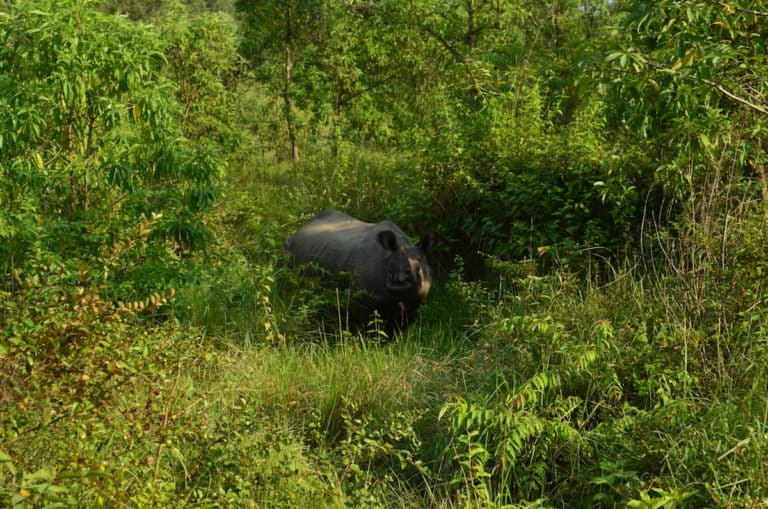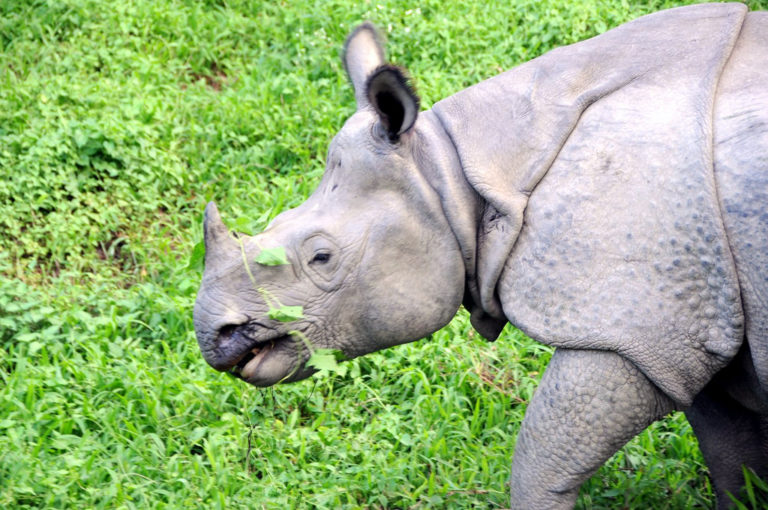- Mikania micrantha, a plant native to the Americas, has been present in Chitwan National Park since the 1990s. As of 2010, it was present in 20 percent of the park, becoming a threat to wildlife and local people’s livelihoods.
- The plant is particularly prevalent in habitats like wetlands, grasslands and riverine forests, which are also favored habitats for the more than 600 one-horned rhinos living in the park.
- Mikania chokes out native fodder species, pushing rhinos and other grazers out of the safety of the park and increasing human-wildlife conflict, researchers have found.
- Mikania is extremely difficult to eradicate since plants produce up to 40,000 seeds per year and can re-root from even small stems. Efforts are underway to improve removal strategies and engage local communities in the work.
A little plant can go a long way — so long it has earned the name “mile-a-minute weed.” This prodigious propagator is Mikania micrantha, a plant that reached Asia from Central and South America and today is so widespread in Nepal’s Chitwan National Park that it has become a threat to the one-horned rhinoceros’ (Rhinoceros unicornis) grazing grounds, other wildlife and local people’s livelihoods.
“How did that plant arrive in Nepal? That’s a mystery,” Dirgha Ghimire, director of the Institute for Social and Environmental Research – Nepal, told Mongabay. Some, he said, believe Mikania came as a dried grass used to cushion goods inside shipping crates, while others think monsoon rains brought its seeds from India. Another theory is that it was introduced into India after the Second World War to camouflage airfields and gradually spread into Nepal. What is certain is that the plant was first reported in eastern Nepal in the early 1960s, and was identified in Chitwan in 1997. By 2010 it was present in 20 percent of the Park, and it is now the most pervasive invasive plant in Chitwan and is also well distributed in other areas of the Terai region.

Mikania is a perennial plant that creates havoc by covering and smothering other plants. It kills native flora, including grasses and sapling trees that are important fodder plants for the more than 600 rhinos living in the park and its surroundings. A 2011 survey of Chitwan found that that Mikania is particularly prevalent in some of the preferred rhino habitats, such as wetlands, tall grasslands, and riverine forests. The plant also climbs and twines on crops, bushes, walls and fences, and its shoots can grow up to 27 millimeters a day. It is so vigorous that in a few months a single plant can cover over 25 square meters. Every year a single plant releases around 40,000 seeds that are then dispersed by wind, but can also travel on clothing or hair. Furthermore, its nodes root very easily.
“It’s really strong, it’s like a vine, and if you pull it off the ground and it breaks it has a sort of a sticky, oily feel, and it’s difficult to remove,” said Abigail Sullivan, a research associate at Arizona State University’s Decision Center for a Desert City. Sullivan is an environmental social scientist who studied Mikania removal activities in community forests around the border of Nepal’s Chitwan National Park, the so-called “buffer zone”.
“There are other invasive plants in Chitwan and in the Terai region that are almost as prevalent as Mikania, but they don’t cause quite the same issues,” she said.
The plant, she explained, produces chemicals that inhibit the growth of other plants, and contains alkaloids that limit the amount of Mikania rhinos and other animals can successfully digest. Furthermore, it grows over grasses and small trees that people around Chitwan rely on to maintain farm animals and crops, and use for firewood and timber.
On top of that, Mikania influences the movement of rhinos to other areas of the park, exacerbating human-wildlife conflict. “Mikania is taking more and more every year, [and there’s] less and less grass for the rhino to feed on, so the rhinos come out of the jungle and feeds on farmers’ crops,” explained Ghimire.

A recent study found that from 2003–2013 an average of 30 people per year were attacked by wild animals in and around Chitwan National Park, sustaining minor to fatal injuries. Rhinos were responsible for 126 attacks, 38 percent of the total incidents. Along with increasing animal populations and habitat improvements in the buffer zone, Mikania was cited as a potential cause of these attacks.
According to the study, “[t]he increase in attacks in the buffer zone community forests and croplands … indicates that attacking animals, including rhinoceroses and bears, are moving out of the Park as it becomes increasingly difficult to find suitable food, shelter and breeding sites within the Park as a result of habitat destruction and human interference.”
Still, Ghimire emphasized, local people love rhinos as they are seen as a part of their cultural heritage, and wildlife tourism helps to support their livelihoods. For this reason, area residents and conservationists are pulling together to fight this alien plant.
“We do cleanings two times a year, and are working with local communities: we go there, we work with them, we teach them the techniques, and we expect them to collaborate in actually doing it,” said Ghimire.

But not everybody participates in efforts to remove Mikania. So, Sullivan and her colleagues embarked on a study to discover what factors are influencing locals’ participation. This research employed a survey with 1,041 households across 21 community forests in and near the park’s buffer zone, and took into account economic and geographic data as well. Findings show that people who are more dependent on community forest resources and perceive Mikania as a threat are more likely to engage in Mikania removal. But those factors, Sullivan says, don’t explain the whole picture.
“There’s still a relatively low level of participation in Mikania removal: it’s somewhere around 30 percent. So there’s so more to further understand why some people are choosing to participate and others are not.”
The survey didn’t identify a single cause influencing people’s participation. But Sullivan did note that almost all the community members surveyed said they wished someone could tell them how to most effectively remove Mikania.
People here have traditionally removed unwanted plants by pulling and uprooting or cutting and slashing, and then burning them. But since Mikania can reproduce both sexually (via seeds) and asexually (regrowing from stems), these methods can end up unintentionally distributing the plant.

“All the methods they are using on other plants aren’t working on Mikania, so getting information out there is important, and also increasing community relationships between some of the NGOs in the area that have this information about Mikania removal is important because a lot of communities expressed distrust in NGOs, in the National Park, and in other organizations that have information that could help the communities.”
This, Sullivan said, is because many believe money and resources are not always distributed fairly, or feel NGOs pursue their own agendas rather than working in the interest of local communities.
The Mikania problem goes much deeper than just a lack of engagement in removal efforts. “The management techniques they use in the broader park are serving to support Mikania growth,” said Sean Murphy, invasive species expert at the Centre for Agriculture and Biosciences International, who in 2013 published a landmark study on the plant’s impact on rhino habitat in Chitwan.
One of the major problems, he said, is that surrounding communities traditionally burn grassland to spur new grass growth. This promotes the spread of Mikania, because it is more efficient than native plants at making the most of the nutrients that are found in the soil after a burn.
“One option would be to restrict burning of some areas important for the rhinoceros to once every few years; some controlled burning is important to maintain the grassland habitats in the longer term but further research is needed to determine the optimal regime for burning,” he wrote in his study. “Protection of areas from burning can be achieved by the use of fire breaks but the local communities and others who set fires need to be engaged in the plan, to avoid accidental burning of these areas.”
Murphy added that people who go to the forest to collect resources often end up carrying Mikania into new areas. Moreover, conservationists still do not know what is the most efficient way to remove this plant, and removal efforts can inadvertently end up contributing to the spread and growth of the plant. One of the techniques being experimented with, says Murphy, is to bag and burn Mikania on the spot in a small pit rather than transporting it through the forest.
“The interventions are based on what we know about the ecology of the plant and to keep interventions low-tech and based on what communities are familiar with and have resources to implement.”

Removal activities are being organized in community forests because here live the very people who directly benefit from a healthy environment, and experts agree that locals should play a pivotal role in the fight against invasive plants.
“One of the things we are definitely working on is understanding how communities are already trying to tackle the Mikania problem,” said Abigail York, associate professor of governance and public policy at Arizona State University’s School of Human Evolution and Social Change.
“These communities have been managing forests for hundreds of years, and in the community forests there are many vines that are native to Nepal that people go in and try to manage,” she said, highlighting that one of the major issues is that people simply cut the vines and then leave them on the ground. This is a problem with Mikania because the plant can re-root from even small stems.
“It’s imperative that we understand what communities already do, and if possible just helping them modify those practices, not bringing in something completely new because in many of these communities they don’t have a lot of resources,” York said.
Local communities are the ones on the frontline of this fight, she said, so removal activities should be tailored to them.
“Expecting communities to completely change how they manage the resources would require a lot of probably money and training and other things that frankly we don’t have.”
FEEDBACK: Use this form to send a message to the author of this post. If you want to post a public comment, you can do that at the bottom of the page.